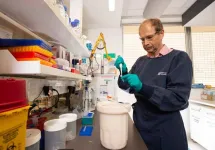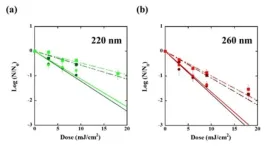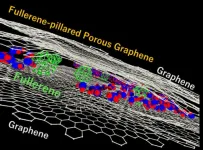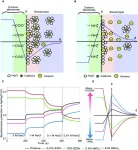(Press-News.org)
QUT researchers have developed a new approach for designing molecular ON-OFF switches based on proteins which can be used in a multitude of biotechnological, biomedical and bioengineering applications.
The research team demonstrated that this novel approach allows them to design and build faster and more accurate diagnostic tests for detecting diseases, monitoring water quality and detecting environmental pollutants.
Professor Kirill Alexandrov, of the QUT School of Biology and Environmental Science, lead scientist on the CSIRO-QUT Synthetic Biology Alliance and a researcher with the ARC Centre of Excellence in Synthetic Biology, said that the new technique published in the prestigious scientific journal Nature Nanotechnology demonstrated that protein switches could be engineered in a predictable way.
Professor Alexandrov said currently available ‘point of care’ diagnostic tests which provided immediate results, such as blood glucose, pregnancy, and COVID test kits, used protein-sensing systems to detect the presence of sugar, pregnancy hormones, and COVID proteins.
“These, however, represent only a tiny fraction of what is needed in patient-focused healthcare model,” Professor Alexandrov said.
“However, developing new sensing systems is a challenging and time-consuming trial-and-error process.
“The new ‘protein nano-switch’ method can massively accelerate development of similar diagnostics by decreasing the time and increasing the success rate. It uses proteins modified to behave like ON/OFF switches in response to specific targets.
“The advantage of our approach is that the system is modular, similar to building with Lego bricks, so you can replace parts easily to target something else – another drug or a medical biomarker, for example.”
Professor Alexandrov said the method offered the possibility of building many different diagnostic and analytic tests, with a wide range of possible applications including diagnostics in human and animal health, testing kits for water contamination, and detecting rare earth metals in samples to direct mining efforts.
The multidisciplinary research team included scientists from QUT and the ARC Centre of Excellence in Synthetic Biology, consisting of lead researcher Professor Kirill Alexandrov, Dr Zhong Guo, Cagla Ergun Ayva, Patricia Walden and Adjunct Professor Claudia Vickers.
The QUT team collaborated with leading electrochemists Evgeny Katz and Oleh Smutok from Clarkson University, in New York, and chemical pathologist Dr Jacobus Ungerer from Queensland Health.
To demonstrate the technology, the team focused on a cancer chemotherapy drug that is toxic and requires constant measurement to ensure patient welfare.
“Too little of the drug won’t kill the cancer, but too much could kill the patient,” Professor Alexandrov said.
The sensor the team designed for the drug uses a colour change to identify and quantify the drug.
Professor Alexandrov said the next step was the for the sensor to be tested in Queensland Health laboratories for approval for use in clinical setting.
Professor Kirill Alexandrov.
“It’s really exciting, because it’s the first time an artificially designed protein biosensor may be actually suitable for a real-life diagnostic application” Professor Alexandrov said.
Dr Ungerer said the protein-engineering technology developed by the research team provided a novel means to create laboratory tests.
“This has the potential to improve and expand laboratory testing, which will result in substantial health and economic benefits,” Dr Ungerer said.
Dr Guo said these advancements were made possible by an international and interdisciplinary team and excellent teamwork.
Professor Alexandrov said that the next step was to take this approach and standardise and scale it, to then start building more sophisticated sub-systems. He said there are two future directions for the work.
“One is to develop computer models that allow us to design and build the switches even more rapidly and precisely,” he said.
“The other is to demonstrate the scale and potential of the technology by building many switches for different diagnostic applications.”
Professor Alexandrov said the team were currently modifying existing proteins, but in the future, they could use the same principles to develop components that did not exist and would be designed from scratch.
“The new technique provides scientists unprecedented control over construction of protein-based sensing systems,” he said.
The article “Development of epistatic YES and protein logic gates and their assembly into signalling cascades” is published in Nature Nanotechnology.
END
(Memphis, Tenn. – July 27, 2023) St. Jude Children’s Research Hospital proudly announces that Jinghui Zhang, Ph.D., Member of the Department of Computational Biology, has been elected as a Fellow of the International Society for Computational Biology.
Zhang is one of 15 scientists given this distinction in 2023. She’s being honored for the development and application of innovative computational methods, discovering novel targets and accelerating research and genomic data sharing to advance the diagnosis, treatment and surveillance of pediatric cancers and survivors.
“I ...
Dr. Raymond Chan's team from the Institute of Psychology of the Chinese Academy of Sciences and his collaborators have recently shown that amotivation and anhedonia, rather than expressive dysfunction, play a crucial role in determining the social functioning of schizophrenia patients.
The study was published in Nature Mental Health.
Negative symptoms refer to the loss of normal functioning, including anhedonia, avolition, alogia, asociality, and affective blunting, and have been shown to be the most important predictors ...
Conventional wisdom holds that storing fat around your belly puts you at increased risk for type 2 diabetes. But surprising new findings from the University of Virginia School of Medicine suggest that naturally occurring variations in our genes can lead some people to store fat at the waist but also protect them from diabetes.
The unexpected discovery provides a more nuanced view of the role of obesity in diabetes and related health conditions. It also could pave the way for more personalized medicine – treatments tailored to the individual. ...
COLUMBUS, Ohio – As the next generation of giant, high-powered observatories begin to come online, a new study suggests that their instruments may offer scientists an unparalleled opportunity to discern what weather may be like on far-away exoplanets.
Dubbed the extremely large telescopes (ELTs), these observatories, which include the Extremely Large Telescope (ELT), the Giant Magellan Telescope (GMT), and the Thirty Meter Telescope (TMT), will be some of the largest ground-based telescopes ever built, and their instruments are expected to exceed ...
Malta – We are delighted to announce the launch of the Polyphenols Innovation Network (PIN), a pioneering initiative designed to accelerate progress in the field of polyphenols research by fostering a collaborative and innovative environment.
Under the banner of PIN, our mission is to assemble a diverse team of multidisciplinary experts, committed to advancing the frontiers of polyphenols research, applications, and innovation.
Projects of PIN:
Three pioneering projects have been earmarked for initiation under the auspices ...
INDIANAPOLIS – Accessing neurologic care often presents physical, geographical and financial challenges to patients, many of whom face chronic and disabling conditions. With a nationwide scarcity of neurologists in the U.S., especially in rural areas, disparities in access to timely neurological assessment and treatment are not uncommon. Telehealth addresses access to care as well as other inequity issues.
To meet the need for prompter care and to diminish disparity for rural veterans, the U.S. Department of Veterans’ Affairs (VA) National Teleneurology Program was funded in 2019 by the VA’s Office of Rural Health. The program is a patient-centered, ...
The global outbreak of severe acute respiratory syndrome coronavirus 2 (SARS-CoV-2) and its new variants has created a need for effective disinfection technologies to protect against harmful pathogens. While vaccines offer some protection, their effectiveness against future variants is uncertain. Therefore, additional strategies are important during the pre-vaccine stage.
UV irradiation has lately emerged as a safe, effective, and convenient strategy to inactivate and eliminate disease-causing micro-organisms. The wavelength range of 200-235 ...
Separation processes are essential in the purification and concentration of a target molecule during water purification, removal of pollutants, and heat pumping, accounting for 10–15% of global energy consumption. To make the separation processes more energy efficient, improvement in the design of porous materials is necessary. This could drastically reduce energy costs by about 40–70%. The primary approach to improving the separation performance is to precisely control the pore structure.
In this regard, ...
Did you know rivers carry about 40 trillion metric tons of river water into the ocean every year? This meeting point, known as the estuary, holds great potential for electricity generation. Mixing the two types of water -- seawater and river water containing different salt concentrations -- releases a substantial amount of Gibbs free energy, which can be converted to electricity using semipermeable membranes. However, the performance of membranes has limited the economic viability of membrane-based approaches, leaving the vast potential of this naturally abundant energy source largely untapped.
To overcome the challenges associated with the membranes, researchers have developed membrane-free ...
Roughly six million Black people moved away from the American South during the Great Migration between 1910 and 1970, hoping to escape racial violence and discrimination while pursuing economic and educational opportunities. Now, research has uncovered a link between this historic event with present-day inequalities and implicit biases.
In a new Social Psychological and Personality Science article, researchers report that current implicit bias among White people at the county-level is associated with the proportion of Black residents living in that county during the Great Migration (circa 1930). The research supports the Bias ...







